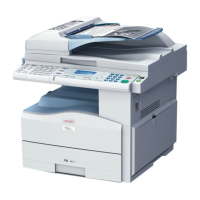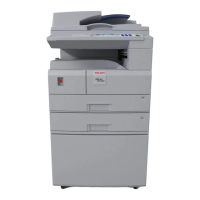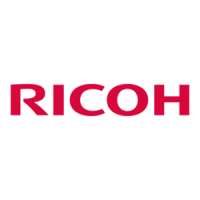Copy Process
SM 6-17 D017/D018/D019/D020
Detailed
Descriptions
4. Development
The magnetic developer brush on the development rollers comes in contact with the latent
image on the drum surface. Toner particles are electrostatically attached to the areas of the
drum surface Were the laser reduced the negative charge on the drum.
5. ID Sensor
The laser forms a sensor pattern on the drum surface. The ID sensor measures the
reflectivity of the pattern. The output signal is one of the factors used for toner supply
control. Also, the ID sensor measures the reflectivity of the drum surface. The output signal
is used for charge roller voltage control.
6. Image Transfer
Paper is fed to the area between the drum surface and the transfer roller at the proper time
for aligning the copy paper and the developed image on the drum surface. Then, the
transfer roller applies a high positive charge to the reverse side of the paper. This positive
charge pulls the toner particles from the drum surface onto the paper. At the same time, the
paper is electrostatically attracted to the transfer roller.
7. Paper Separation
Paper separates from the drum as a result of the electrostatic attraction between the paper
and the transfer roller. The discharge plate helps separate the paper from the drum.
8. Cleaning
The cleaning blade removes any toner remaining on the drum surface after the image
transfers to the paper.
9. Quenching
The light from the quenching lamp electrically neutralizes the charge on the drum surface.

